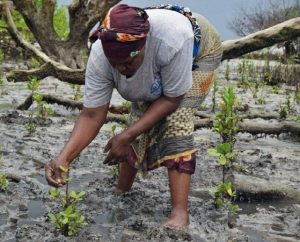Mangroves protect infrastructure and communities from storms, sequester carbon, and provide fisheries with nursing grounds. PHOTO/LIGHTOLIFE
By PATRICK MAYOYO
A shift in the way we think about the benefits mangroves provide to coastal regions could yield significant economic and biodiversity gains and protect millions from flooding, a new research has revealed.
The University of Queensland-led study shows current conservation efforts typically target biodiversity protection whilst minimising conflict with economic interests, while failing to consider the huge benefits provided by ecosystems.
The researchers are recommending an optimised conservation planning perspective that operates within this framework and puts more emphasis on these ecosystem services according to their work published in Nature Communications.
Ecosystems provide many services to humanity, including food provisioning, air and water purification and climate change mitigation. These ecosystem services are threatened by global biodiversity loss caused by anthropogenic activities such as urbanisation, agriculture and fishing.
Alvise Dabalà, now at the University of the Azores and whose Masters project at UQ formed the basis of this study, said human activities, such as deforestation and coastal development have led to extensive mangrove loss across the globe.
“They protect infrastructure and communities from storms, sequester carbon, and provide fisheries with nursing grounds, so their rapid destruction is devastating to witness,” Mr Dabalà said in a press release.
The team is using the United Nations’ Global Biodiversity Framework, which recommends an increase in protected areas to 30 per cent of the world as the basis of their proposal.
“As it stands, current conservation efforts just aren’t doing enough to take advantage of these services,” Mr Dabalà added.
The researchers identified priority areas that maximise both the protection of mangrove biodiversity and their ecosystem services.
“It’s somewhat of a juggling act, where we have to consider the trade-offs between biodiversity protection, economic conflicts, and ecosystem services,” Mr Dabalà said.
Their study reveal that despite 13.5% of the mangrove distribution being currently strictly protected, all mangrove species are not adequately represented and many areas that provide disproportionally large ecosystem services are missed.
“But if done properly, this target has the potential to safeguard AU$25.6 billion of coastal property value, globally,” they note.

In 2011, a total of 194 countries agreed, via the Convention of Biological Diversity Aichi Target 11, that by 2020 they would protect at least 17% of their terrestrial systems and inland waters. PHOTO/UN
Their findings suggest that there is a pressing need for including ecosystem services in protected area design and that strategic prioritisation and coordination of mangrove conservation could provide substantial benefits to human wellbeing.
“It would also protect 6.1 million coastal-dwelling people against the impacts of flooding, and safeguard over one billion tonnes of sequestered carbon,” Mr Dabalà noted.
In 2011, a total of 194 countries agreed, via the Convention of Biological Diversity Aichi Target 11, that by 2020 they would protect at least 17% of their terrestrial systems and inland waters, and 10% of their coastal zones and marine regions, by implementing protected areas and other effective area-based conservation measures.
Despite failing to meet these targets, the first draft of the post-2020 Global Biodiversity Framework calls for 30% of the Earth to be protected to conserve biodiversity and enhance nature’s contribution to people through ecosystem services.
Mr Dabalà said expanding Australian mangrove protection would be particularly beneficial for carbon sequestration and biodiversity conservation as they stand out as some of the most diverse, carbon-rich mangrove forests.
UQ’s Professor Anthony Richardson said to achieve these outcomes boils down to a shift in perspective.
“In some areas of the world, we recognise that human pressure could be so high that the value of ecosystem services would not compensate for the loss and could result in complications in implementing protection,” Professor Richardson said in a press release.
Prof Richardson, however, said for multiple ecosystems, including mangroves, we’ve quantified the benefits associated with considering the services these ecosystems provide – the figures are undeniable.
“We know that long-term gains from biodiversity protection are often greater than short-term gains from anthropogenic activities, so this shift in thinking must happen soon,”Prof Richardson noted.
Professor Richardson said developing biodiversity and ecosystem services data should be a priority to incorporate into applied conservation plans.
“Implementation of these plans should then follow different conservation practices that target local communities’ needs specifically,” he said.
He said moving forward, decision-makers and other stakeholders need to focus on protected area implementation, management, and monitoring to provide solid conservation outcomes.












